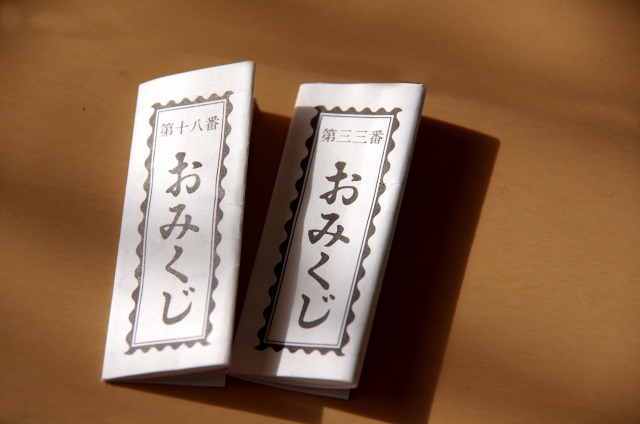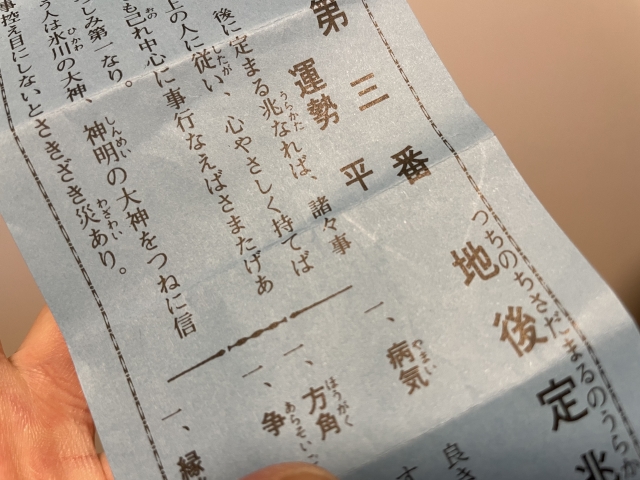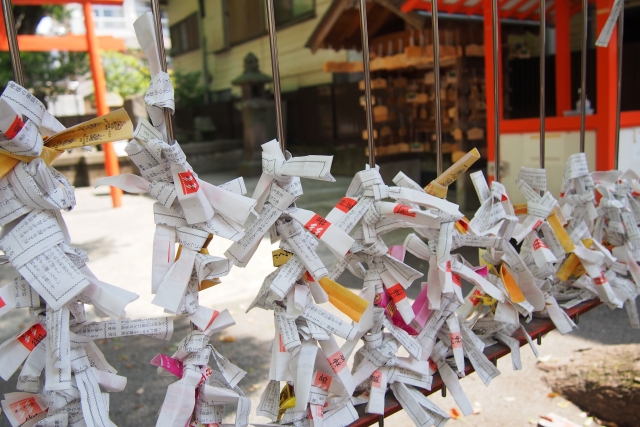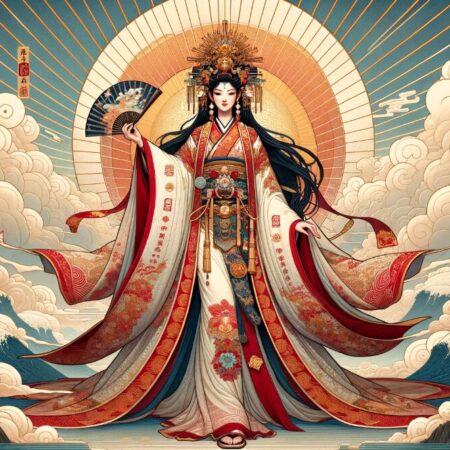Have you ever drawn an omikuji? Almost every Japanese person has drawn an omikuji at least once, but do you know the details and meanings of its contents? What kind of history does omikuji have? Additionally, why do we sometimes tie the omikuji after drawing it, and how should we dispose of it if we take it home? This time, let's take a look at the history and contents of omikuji, something that is familiar yet surprisingly not well-known.
History of Omikuji

First, let's look at the origins of Japanese omikuji. An important event in the history of omikuji is the introduction of "Tenjiku Reizen" from China during the Nanbokucho period to the early Muromachi period. "Tenjiku Reizen" refers to an ancient Chinese form of lottery, which became the prototype of Japanese omikuji.
Gansan Daishi, a monk of the Tendai sect, created the "Gansan Daishi Hyakusen" based on "Tenjiku Reizen." This Gansan Daishi Hyakusen laid the foundation for Japanese omikuji and became very popular during the Edo period. This lottery predicted fortunes and auspices in the form of Chinese poetry, bearing a format quite similar to modern omikuji.
In the Meiji period, the new government issued the "Shinbutsu Bunri" decree in Keio 4 (1868), which separated Shinto and Buddhism. Due to this decree, shrines could no longer use omikuji of Buddhist origin, necessitating the development of shrine-specific omikuji. As a result, omikuji at shrines often included waka poems, while those at temples featured Chinese poetry.
Thus, shrine omikuji were reorganized during the Meiji period, taking on a different form from the Buddhist-influenced temple omikuji. This is why, in modern times, people often find shrine omikuji easier to understand than temple omikuji.
Types and Meanings of Omikuji Fortunes

Let's look at the different types of omikuji fortunes and their meanings.
Daikichi (Great Blessing)
Overview: Daikichi is the best fortune in omikuji.
Meaning: It indicates that very good things will happen overall. New challenges and plans are likely to succeed, and efforts will bear fruit. You can expect favorable outcomes in all areas, including the fulfillment of wishes, recovery of health, prosperity in business, and improvement in relationships.
Chūkichi (Middle Blessing)
Overview: This indicates good fortune, second only to Daikichi.
Meaning: Things will proceed smoothly, but it does not guarantee absolute success like Daikichi. Effort and proper planning are necessary, but the results are likely to meet expectations.
Shōkichi (Small Blessing)
Overview: This indicates relatively good fortune.
Meaning: Effort and patience are required, but things are expected to proceed in a positive direction. It is a time for small successes and progress, and it is recommended to move forward with an optimistic attitude.
Kichi (Blessing)
Overview: This generally indicates good fortune.
Meaning: It suggests that things will go smoothly. Without special effort, you will achieve good results through the natural flow of events. It is a time when daily life, work, and relationships progress in a favorable direction.
Hankichi (Half Blessing)
Overview: This indicates partially good fortune.
Meaning: Success can be expected in some areas, but not everything will go smoothly. Good results can be obtained in specific fields or situations, but caution is needed in others.
Suekichi (Future Blessing)
Overview: This indicates that things will improve in the future.
Meaning: Even if the current situation is not very good, there are signs of improvement in the future. Continued patience and effort will gradually lead to better outcomes. It requires planning and action with future success in mind.
Sueshōkichi (Small Future Blessing)
Overview: This indicates modest future fortune.
Meaning: Small difficulties are expected, but by dealing with them patiently, you can find small successes and joys. It is important to value daily small achievements without having high expectations.
Kyō (Bad Luck)
Overview: This indicates bad fortune.
Meaning: Difficulties and obstacles are expected, requiring cautious actions. It is not a suitable time to start something new; instead, it is important to avoid risks and proceed with careful planning. Take this as an opportunity to maintain or review the current situation and respond calmly.
Shōkyō (Small Bad Luck)
Overview: This indicates slightly better than Kyō, but still requires caution.
Meaning: Problems may arise, but they are not major obstacles. By paying close attention and addressing issues before they escalate, you can avoid trouble. Handling small problems carefully can prevent larger difficulties.
Hankyō (Half Bad Luck)
Overview: This indicates partially bad fortune.
Meaning: Difficulties are expected in some areas, but overall, they are not major problems. Cautious actions are needed in specific fields. By thoroughly reviewing plans and managing risks, the negative impact can be minimized.
Suekyo (Future Bad Luck)
Overview: This is the mildest form of bad fortune.
Meaning: Small difficulties and obstacles are expected, but it is important to deal with them positively. Addressing issues before they worsen can resolve problems. Acting cautiously and responding calmly is required.
Daikyō (Great Bad Luck)
Overview: This indicates the worst fortune.
Meaning: Many difficulties and obstacles are expected, requiring especially cautious actions. The risk is high, and things may not go as planned. It is recommended not to start anything new and to maintain the current situation cautiously. Seeking advice from trusted individuals and preventing troubles in advance is important.
List of Omikuji Contents
Omikuji provides not only fortunes but also advice on various aspects of life. Here, we will explain the typical items found in omikuji and their meanings in detail.
Wish (Negai Goto)
Meaning: This provides advice on whether your wish will come true. It indicates whether a specific wish will be realized and what efforts are necessary.
Example:
- Great Blessing (Daikichi): "Your wish will come true soon. Proceed with confidence." (Indicates a time when the wish will be fulfilled. Encourages proactive action.)
- Middle Blessing (Chūkichi): "Your wish will come true in the near future. Some effort is needed." (Some effort is required, but results are promising.)
- Bad Luck (Kyō): "Your wish is unlikely to come true. Patience is needed now." (It will take time for the wish to come true. Patience is necessary.)
Waiting Person (Machibito)
Meaning: This provides advice on whether the person or thing you are waiting for will come.
Example:
- Good Fortune (Kichi): "The person you are waiting for will come soon." (The awaited person will appear soon.)
- Bad Luck (Kyō): "The person you are waiting for might not come. Consider another approach." (The awaited person is unlikely to appear.)
Lost Item (Usemmono)
Meaning: This provides advice on whether a lost item will be found.
Example:
- Good Fortune (Kichi): "The lost item will be found soon." (The lost item will be found quickly.)
- Bad Luck (Kyō): "The lost item is hard to find. It might be better to look for a new one." (Finding the item is difficult. Consider getting a new one.)
Travel (Ryokō)
Meaning: This provides advice on travel, including the timing and destination.
Example:
- Good Fortune (Kichi): "Travel is favorable. It will be an enjoyable trip." (The trip will be successful and enjoyable.)
- Bad Luck (Kyō): "Avoid traveling. There are risks involved." (Traveling has risks and should be avoided.)
Business (Shōbai)
Meaning: This provides advice on business and commercial activities, including the current business situation and new ventures.
Example:
- Good Fortune (Kichi): "Business will proceed smoothly. Try new challenges." (Business will progress well. New ventures are likely to succeed.)
- Bad Luck (Kyō): "Business is stagnant. It's necessary to review plans carefully." (Business might face stagnation. Reviewing plans is needed.)
Studies (Gakumon)
Meaning: This provides advice on studies and academic pursuits, including progress in studies and exam results.
Example:
- Good Fortune (Kichi): "Studies are going well. Continued effort will yield results." (Studies are progressing well, and efforts will be rewarded.)
- Bad Luck (Kyō): "It's hard to focus on studies. It's important to improve the study environment." (Difficult to concentrate on studies. Revising the study environment is necessary.)
Market (Sōba)
Meaning: This provides advice on the stock market and investments, including market trends and investment timing.
Example:
- Good Fortune (Kichi): "The market is favorable. Investment opportunities are coming." (The market is favorable, making it a good time for investments.)
- Bad Luck (Kyō): "The market is unstable. Avoid risks." (The market is unstable. Risky investments should be avoided.)
Conflict (Arasoigoto)
Meaning: This provides advice on disputes and litigation, including the outcome and how to handle conflicts.
Example:
- Good Fortune (Kichi): "You will win the dispute. Proceed with confidence." (High chances of winning the conflict.)
- Bad Luck (Kyō): "The dispute is unfavorable. Consider reconciliation." (Unfavorable in conflicts. Consider reconciliation.)
Love (Ren'ai)
Meaning: This provides advice on love, including the progress of romantic relationships.
Example:
- Good Fortune (Kichi): "Love is going well. Value your honest feelings." (Love is progressing smoothly. Honesty is important.)
- Bad Luck (Kyō): "There are obstacles in love. Take your time." (There are obstacles in love. Proceed cautiously.)
Relocation (Tenkyō)
Meaning: This provides advice on moving or relocating, including the timing and new location.
Example:
- Good Fortune (Kichi): "Relocation is favorable. Success can be expected in the new environment." (Moving will bring positive results. Success is expected in the new environment.)
- Bad Luck (Kyō): "Avoid relocating. Wait for a better time." (Avoid moving. The timing is not favorable.)
Childbirth (Shussan)
Meaning: This provides advice on childbirth, including the smoothness and precautions of the process.
Example:
- Good Fortune (Kichi): "Childbirth will go smoothly. Both mother and child are healthy." (Childbirth will proceed smoothly. Both mother and child will be healthy.)
- Bad Luck (Kyō): "Childbirth requires caution. Listen carefully to the doctor's advice." (Childbirth requires caution. Follow the doctor's advice closely.)
Illness (Byōki)
Meaning: This provides advice on health and illness, including current health status and progression of illness.
Example:
- Good Fortune (Kichi): "Illness will recover. Resting is important." (Illness will improve. Proper rest is crucial.)
- Bad Luck (Kyō): "Illness may linger. Early treatment is necessary." (Illness may last longer. Early treatment is needed.)
Marriage Proposal (Endan)
Meaning: This provides advice on marriage proposals and marriages, including fortune and good matches.
Example:
- Good Fortune (Kichi): "The marriage proposal is a good match. There is no problem in proceeding." (A good marriage match is expected. Proceeding is favorable.)
- Bad Luck (Kyō): "There are issues with the marriage proposal. It’s better to reconsider." (There are problems with the proposal. Reconsideration is necessary.)
Buying and Selling (Urikai)
Meaning: This provides advice on transactions and deals, including timing and success of the transactions.
Example:
- Good Fortune (Kichi): "Buying and selling will proceed smoothly. Great profit is expected." (Transactions will go smoothly. Profit is expected.)
- Bad Luck (Kyō): "Avoid transactions. There are many unfavorable conditions." (Transactions should be avoided. Many unfavorable conditions exist.)
Direction (Hōi)
Meaning: This provides advice on directions, indicating whether it is good or bad to proceed in a specific direction.
Example:
- Good Fortune (Kichi): "The northeast direction is favorable. Good things will happen if you go there." (Proceeding in a specific direction will bring good results.)
- Bad Luck (Kyō): "Avoid the southwest direction. Troubles await." (Avoid proceeding in a specific direction. Troubles are expected.)
Support (Kakaebito)
Meaning: This provides advice on whether there are trustworthy or reliable people around you.
Example:
- Good Fortune (Kichi): "There is someone you can trust nearby. Seek help when in trouble." (There are trustworthy people around. Seek help when needed.)
- Bad Luck (Kyō): "There might be few reliable people around now. Consider solving it yourself." (Few trustworthy people. Self-reliance is necessary.)
Lost Items (Sagashimono)
Meaning: This provides advice on whether you will find what you are looking for, including lost items and ways to find them.
Example:
- Good Fortune (Kichi): "The lost item is nearby. Search again." (The lost item is nearby. Search again to find it.)
- Bad Luck (Kyō): "The lost item is hard to find. Consider getting a new one." (Finding it is difficult. Consider getting a new one.)
Reasons and Places for Tying Omikuji

Many people who have drawn an omikuji have the experience of tying it afterward. Why do we tie omikuji? The act of tying the omikuji at the shrine after drawing it has the meaning of connecting with the gods. By tying it, you can entrust your fortune to the gods, expressing gratitude for a good result or wishing for better fortune if the result is bad. It is also recommended to tie it with your non-dominant hand. This symbolizes achieving a difficult task and is believed to turn bad fortune into good fortune.
When tying omikuji, it is important to use the designated places provided by the shrine. This ensures a proper connection with the gods. A crucial point to note is to avoid tying omikuji to sacred objects such as sacred trees or purification fonts. Tying omikuji to these sacred places can harm the spirit of the gods or the trees, so it is advisable to use the designated tying spots.
How to Dispose of Omikuji
After drawing an omikuji, if you want to keep it as a guide for your life, you can take it home. However, it's also important to know the proper way to dispose of omikuji when it is no longer needed. Here are the correct methods for disposing of omikuji:
-
Dispose of it at the Shrine or Temple where you drew it
The most appropriate method is to return the omikuji to the shrine or temple where you drew it. This is part of "Orei Mairi," which involves giving thanks and reporting the fulfillment of prayers. Old omikuji can be placed in a special box or returned to a designated area. If there is a donation box nearby, it is good to offer an amount equivalent to the omikuji. If you can't find a return box, ask at the shrine or temple office.
-
Dispose of it at a Dondoyaki Ceremony
You can also dispose of omikuji during the "Dondoyaki" ceremony, where New Year's decorations are burned. This event usually takes place around January 15th (Koshogatsu), but the date may vary by region. It is common to wrap the omikuji in Japanese paper or plain paper before disposing of it.
-
Dispose of it at a Nearby Shrine or Temple
If the shrine or temple where you drew the omikuji is far away, you can dispose of it at a nearby shrine or temple. Especially if it's difficult to visit the original location, it's a good idea to consult with a local shrine or temple.
-
Mail it with Permission from the Shrine or Temple
If you drew the omikuji while traveling and can't return it in person, you can mail it back. However, confirm in advance whether the shrine or temple accepts mailed omikuji and if there is any fee for the service.
-
Dispose of it as Burnable Trash at Home
If you absolutely can't take the omikuji to a shrine or temple, you can dispose of it as burnable trash at home. In this case, purify it with salt and dispose of it with gratitude. Avoid tearing it up.
Summary
What did you think? As we have introduced, omikuji was brought to Japan from ancient China and has been cherished by people while changing its form over time. Its history was founded on the "Genzan Daishi Hyakusen" by Genzan Daishi, and following the separation of Shinto and Buddhism in the Meiji period, it has taken on different forms in shrines and temples. Today, omikuji is not just a fortune-telling tool but a guide for life that many people use. By correctly understanding the contents of the omikuji you draw and applying it to your daily actions, it can help you build a better future.
This site introduces various interesting histories and cultures of Japan besides omikuji. If you are interested, we would be delighted if you read other articles as well!



